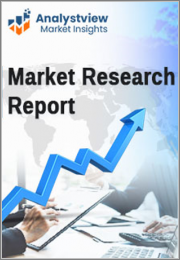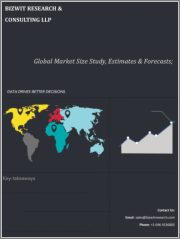
|
시장보고서
상품코드
1290905
자가주사기 시장 : 현황 분석 및 예측(2022-2028)Self-injection Devices Market: Current Analysis and Forecast (2022-2028) |
||||||
자동주입기 시장은 헬스케어 분야의 첨단 기술 채택이 증가함에 따라 예측 기간 동안 CAGR 6%의 높은 성장률을 보일 것으로 예상됩니다. 예를 들어, 2022 년 5월 Jabil Healthcare는 광범위한 적용 범위를 가진 재사용 가능한 약물 전달 장치인 Qfinity ™ 자동 주사기 플랫폼의 출시를 발표했습니다.
제품을 기준으로 시장은 자동 주사기, 펜형 주사기, 웨어러블 주사기, 바늘이 없는 주사기로 구분되며, 2021년에는 펜형 주사기가 압도적인 점유율을 차지할 것으로 예상됩니다. 펜형 주사기는 피하(피부 아래) 또는 근육 내(근육 내)에 약물을 전달하는 데 사용되는 의료기기입니다. 펜형 주사기는 미리 채워진 카트리지 또는 교체 가능한 인슐린 저장소가 들어있는 펜 모양의 장치와 펜 끝에 부착된 주사 바늘로 구성됩니다. 자가 주사를 할 수 있는 편리한 장치로, 만성 질환의 유병률 증가와 함께 이 부문의 성장 요인으로 작용하고 있습니다.
사용 편의성을 기준으로 시장은 일회용과 재사용으로 나뉘며, 2021년 자가주사기 시장에서 일회용 부문이 큰 비중을 차지할 것으로 예상됩니다. 이는 주로 일회용 자가주사기가 무균이며 일회성 사용을 전제로 설계되어 감염 및 오염의 위험이 감소하기 때문입니다. 이는 면역력이 약하거나 감염 위험이 높은 환자에게 특히 중요합니다.
용도에 따라 시장은 암, 자가 면역 질환, 호르몬 질환, 통증 관리 및 기타로 분류됩니다. 2021년 자가주사기 시장에서 암이 가장 높은 점유율을 차지헀습니다. 암의 높은 유병률은 자가주사기 수요 증가의 주요 요인으로 작용하고 있습니다. 예를 들어, 미국 국립암연구소에 따르면 2020년 미국에서 180만 6,590명의 암 환자가 새로 진단을 받고 60만 6,520명이 이 질병으로 사망한 것으로 추정됩니다.
자가주사기 산업 시장 서론에 대한 이해를 돕기 위해 시장은 북미(미국, 캐나다, 기타 북미), 유럽(독일, 영국, 프랑스, 이탈리아, 스페인, 기타 유럽), 아시아태평양(중국, 일본, 인도, 한국, 호주, 기타 아시아태평양), 세계 기타 지역별로 분석되었습니다. 2021년 자가주사기 시장은 노인 인구 증가와 노인 인구의 질병 빈도 증가로 인해 북미가 지배적인 것으로 분석되었습니다. 또한, 주요 시장 기업의 존재와 이 지역의 확립된 의료 인프라는 북미 셀프 인젝터 시장의 주요 점유율에 기인합니다.
목차
제1장 시장 서론
- 시장의 정의
- 주요 목적
- 이해관계자
- 제한 사항
제2장 조사 방법 또는 전제조건
- 조사 과정
- 조사 방법
- 응답자 개요
제3장 시장 요약
제4장 주요 요약
제5장 COVID-19가 세계 자가주사기 시장에 미치는 영향
제6장 세계의 자가주사기 시장 매출, 2020-2028년
제7장 시장 인사이트 : 제품별
- 자동 주사기
- 펜형 주사기
- 웨어러블 주사기
- 무바늘 주사기
제8장 시장 인사이트 : 사용성별
- 일회용
- 재이용 가능
제9장 시장 인사이트 : 용도별
- 암
- 자가면역질환
- 호르몬 장애
- 통증 관리
- 기타
제10장 시장 인사이트 : 지역별
- 북미의 자가주사기 시장
- 미국
- 캐나다
- 기타 북미
- 유럽의 자가주사기 시장
- 독일
- 영국
- 프랑스
- 이탈리아
- 스페인
- 기타 유럽
- 아시아태평양의 자가주사기 시장
- 중국
- 일본
- 인도
- 호주
- 한국
- 아시아태평양(APAC) 기타 국가
- 기타 지역의 자가주사기 시장
제11장 자가주사기 시장 역학
- 시장 성장 촉진요인
- 시장이 해결해야 할 과제
- 영향 분석
제12장 자가주사기 시장 기회
제13장 자가주사기 시장 동향
제14장 수요측과 공급측 분석
- 수요측 분석
- 공급측 분석
제15장 밸류체인 분석
제16장 가격 분석
제17장 전략적 인사이트
제18장 경쟁 시나리오
- 경쟁 구도
- Porter의 Five Forces 분석
제19장 기업 개요
- Ypsomed AG
- BD
- Gerresheimer AG
- Halozyme, Inc.
- Haselmeier
- NuGen Medical Devices
- Owen Mumford Limited
- SHL Medical AG
- Pfizer Inc.
- Amgen Inc.
제20장 면책사항
LSH 23.07.25Self-injection devices are medical devices designed to allow patients to self-administer medications, such as insulin, growth hormones, and other biologics. These devices are typically used by patients who require regular injections and are designed to be easy to use, portable, and discreet. The growth of the market is mainly driven by the factors such as the increasing prevalence of chronic diseases requiring injectable treatments. For instance, as per the International Diabetes Federation, Approximately 537 million adults between 20 & 79 years are living with diabetes. The total number of people living with diabetes is projected to rise to 643 million by 2030 and 783 million by 2045.
The Self-injection Devices Market is expected to grow at a strong CAGR of 6% during the forecast period owing to the increasing adoption of advanced technology in the healthcare sector. For instance, in May 2022, Jabil Healthcare Announces the Launch of the Qfinity™ Autoinjector Platform, a Reusable Drug Delivery Device with Broad Applicability.
Based on product, the market is segmented into autoinjectors, pen injectors, wearable injectors, and needle-free injectors. Pen injectors held dominating share in 2021. Pen injectors are medical devices that are used to deliver medication subcutaneously (under the skin) or intramuscularly (into the muscle). They consist of a pen-like device that contains a pre-filled cartridge or a replaceable insulin reservoir, and a needle that is attached to the end of the pen. The convenient usage of the self-injection of these devices, along with the increasing prevalence of chronic diseases attributes to the growth of the segment.
On the basis of usability, the market is bifurcated into disposable and reusable. The disposable segment held a significant share of the self-injection devices market in 2021. This is mainly due to the fact that disposable self-injection devices being sterile and designed for single use, which reduces the risk of infection or contamination. This is particularly important for patients who have compromised immune systems or are at higher risk for infection.
Based on application, the market is segmented into cancer, autoimmune disorders, hormonal disorders, pain management, and others. The cancer had the largest share in 2021 in the self-injection devices market. The higher prevalence of cancer is responsible for the increasing demand for self-injection devices. For instance, as per the National Cancer Institute, in 2020, an estimated 1,806,590 new cases of cancer will be diagnosed in the United States and 606,520 people will die from the disease.
For a better understanding of the market adoption of the self-injection devices industry, the market is analyzed based on its worldwide presence in the countries such as North America (U.S., Canada, and the Rest of North America), Europe (Germany, UK, France, Italy, Spain, Rest of Europe), Asia-Pacific (China, Japan, India, South Korea, Australia, and Rest of Asia-Pacific), Rest of World. North America dominated the self-injection devices market in 2021 due to the rising geriatric population and increased frequency of diseases among them. Furthermore, the presence of major market players, along with the well-established healthcare infrastructure in the region attributed to the major share of the self-injection devices market in North America.
Some of the major players operating in the market include: Ypsomed AG; BD; Gerresheimer AG; Halozyme, Inc.; Haselmeier; NuGen Medical Devices; Owen Mumford Limited; SHL Medical AG; Pfizer Inc.; and Amgen Inc.
TABLE OF CONTENTS
1 MARKET INTRODUCTION
- 1.1. Market Definitions
- 1.2. Main Objective
- 1.3. Stakeholders
- 1.4. Limitation
2 RESEARCH METHODOLOGY OR ASSUMPTION
- 2.1. Research Process of the Self-Injection Devices Market
- 2.2. Research Methodology of the Self-Injection Devices Market
- 2.3. Respondent Profile
3 MARKET SYNOPSIS
4 EXECUTIVE SUMMARY
5 GLOBAL SELF-INJECTION DEVICES MARKET COVID-19 IMPACT
6 GLOBAL SELF-INJECTION DEVICES MARKET REVENUE, 2020-2028F
7 MARKET INSIGHTS BY PRODUCTS
- 7.1. Autoinjectors
- 7.2. Pen injectors
- 7.3. Wearable injectors
- 7.4. Needle-free injectors
8 MARKET INSIGHTS BY USABILITY
- 8.1. Disposable
- 8.2. Reusable
9 MARKET INSIGHTS BY APPLICATION
- 9.1. Cancer
- 9.2. Autoimmune disorders
- 9.3. Hormonal disorders
- 9.4. Pain management
- 9.5. Others
10 MARKET INSIGHTS BY REGION
- 10.1. North America Self-Injection Devices Market
- 10.1.1. U.S.
- 10.1.2. Canada
- 10.1.3. Rest of North America
- 10.2. Europe Self-Injection Devices Market
- 10.2.1. Germany
- 10.2.2. UK
- 10.2.3. France
- 10.2.4. Italy
- 10.2.5. Spain
- 10.2.6. Rest of Europe
- 10.3. Asia-Pacific Self-Injection Devices Market
- 10.3.1. China
- 10.3.2. Japan
- 10.3.3. India
- 10.3.4. Australia
- 10.3.5. South Korea
- 10.3.6. Rest of APAC
- 10.4. Rest of the World Self-Injection Devices Market
11 SELF-INJECTION DEVICES MARKET DYNAMICS
- 11.1. Market Drivers
- 11.2. Market Challenges
- 11.3. Impact Analysis
12 SELF-INJECTION DEVICES MARKET OPPORTUNITIES
13 SELF-INJECTION DEVICES MARKET TRENDS
14 DEMAND AND SUPPLY-SIDE ANALYSIS
- 14.1. Demand Side Analysis
- 14.2. Supply Side Analysis
15 VALUE CHAIN ANALYSIS
16 PRICING ANALYSIS
17 STRATEGIC INSIGHTS
18 COMPETITIVE SCENARIO
- 18.1. Competitive Landscape
- 18.1.1. Porters Fiver Forces Analysis
19 COMPANY PROFILED
- 19.1. Ypsomed AG
- 19.2. BD
- 19.3. Gerresheimer AG
- 19.4. Halozyme, Inc.
- 19.5. Haselmeier
- 19.6. NuGen Medical Devices
- 19.7. Owen Mumford Limited
- 19.8. SHL Medical AG
- 19.9. Pfizer Inc.
- 19.10. Amgen Inc.














